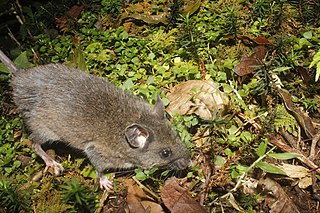
The Mexican vole is a species of vole.

The steppe mouse or mound-building mouse is a species of rodent in the family Muridae. It is found in grassland and other open areas in Austria, Bosnia and Herzegovina, Bulgaria, Croatia, Czech Republic, Hungary, North Macedonia, Romania, Serbia and Montenegro, Slovakia, Slovenia, and Ukraine.
Burt's deer mouse is a species of rodent in the family Cricetidae. It is endemic to Mexico, where it is found only on Montserrat Island off the east coast of Baja California Sur. The species is threatened by predation by feral cats.
Eva's desert mouse is a species of rodent in the genus Peromyscus of the family Cricetidae found only in the Baja California peninsula of Mexico.
The big deer mouse is a species of rodent in the family Cricetidae. It is found only in Guatemala.
Osgood's mouse is a species of rodent in the family Cricetidae. It is found only in Mexico. Its name references Wilfred Hudson Osgood.
The Guatemalan deer mouse is a species of rodent in the family Cricetidae. It is found in Guatemala and Mexico.
The naked-eared deer mouse is a species of rodent in the family Cricetidae. It is found in El Salvador, Guatemala, Honduras, Mexico, and Nicaragua.
The San Lorenzo mouse is a species of rodent in the family Cricetidae. It is endemic to Mexico, where it is found only from the islands of San Lorenzo Norte, San Lorenzo Sur, and Salsipuedes off the east coast of Baja California. The species is threatened by predation by feral and domestic cats, particularly on San Lorenzo Sur.
The Maya mouse is a species of rodent in the family Cricetidae. It is found only in Guatemala.
The brown deer mouse is a species of rodent in the family Cricetidae found only in Mexico.

The black-wristed deer mouse is a species of rodent in the family Cricetidae. It is found in the Sierras de Zempoaltépec, Juárez, and Mazteca, sub-ranges of the Sierra Madre de Oaxaca in southern Mexico, between 1,500 and 2,500 meters elevation.
The plateau mouse is a species of rodent in the family Cricetidae. It is found only in Mexico.
The black-tailed mouse is a species of rodent in the family Cricetidae endemic to Mexico.
The mesquite mouse is a species of rodent in the family Cricetidae found in Mexico and in Arizona in the United States.
The northern rock mouse is a species of rodent in the family Cricetidae. It is found in Mexico and the United States.

The El Carrizo deer mouse is a species of rodent in the family Cricetidae. It is found only in Mexico.
The Chihuahuan mouse is a species of rodent in the family Cricetidae.
Stirton's deer mouse is a species of rodent in the family Cricetidae. It is found in El Salvador, Guatemala, Honduras, and Nicaragua. P. stirtoni is widely distributed and is presumed to have a large population and a tolerance of habitat destruction, though its biology is poorly understood. The species is named after Ruben A. Stirton (1901-1966), an American zoologist associated with the University of California at Berkeley.
The Yucatan deer mouse is a species of rodent in the family Cricetidae. The species is found in Mexico and Guatemala; an example habitat is the Petenes mangroves ecoregion of the Yucatan.




